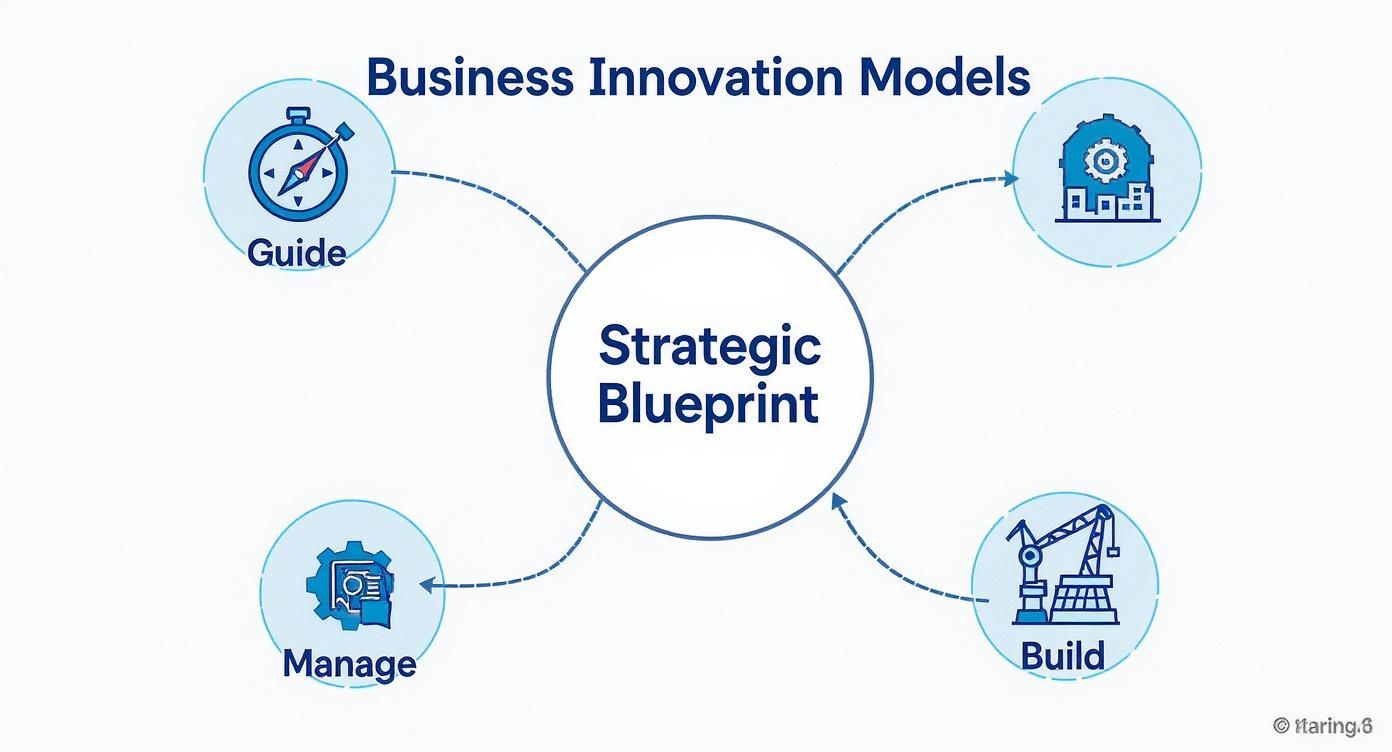Innovation isn't some mythical bolt of lightning. It’s a discipline. And the companies that consistently win don't just wait for good ideas to show up—they build a system for creating them using proven models of business innovation. Think of these frameworks less as rigid rules and more as strategic playbooks for turning raw creativity into real-world results.
Why Business Innovation Models Are Your Strategic Blueprint
You wouldn’t build a house without a blueprint, right? You'd end up with a chaotic, expensive mess that would probably fall down. The same goes for innovation. Without a plan, you get scattered efforts, wasted resources, and brilliant ideas that die on the vine. Business innovation models bring much-needed structure to that creative chaos.
These frameworks are essentially roadmaps that guide how a company tackles change and pursues growth. They provide a methodical way to channel your resources, get your teams on the same page, and focus all that creative energy toward a clear objective. This approach takes the guesswork out of the creative journey by breaking it down into clear, manageable steps. If you want to get into the nitty-gritty of those steps, check out the various processes of innovation that make these models work.
From Small Tweaks to Major Leaps
Innovation isn't a one-size-fits-all game, and different models serve different purposes. Some blueprints are perfect for making small, steady improvements—think of it as renovating the kitchen. You’re making a core part of the house better and stronger without altering its fundamental structure. These models help you solidify your current market position.
Other models are built for bigger, bolder moves. This is like adding a new wing to the house or even designing a skyscraper. These frameworks are for companies looking to shake up an entire industry or invent a whole new market. They offer the guidance needed to navigate the massive uncertainty that comes with launching something brand new.
A business model is the logic of how an organization creates, delivers, and captures value. An innovation model is the blueprint for changing that logic.
Building a Resilient, Forward-Thinking Business
At the end of the day, adopting a business innovation model is about building a more resilient organization. It gives your team a common language and a clear process for turning challenges into opportunities. When everyone understands the "why" and "how" behind your innovation efforts, their contributions become far more powerful, whether they're in the same room or collaborating across continents.
By putting a solid framework in place, you shift from just reacting to problems to proactively building the future you want. Innovation stops being a buzzword and becomes a reliable engine for growth. This guide will walk you through some of the best blueprints out there, helping you find and implement the right one for your team.
Getting to Grips With the Four Core Types of Innovation
Before we dive into the specific models of business innovation, we need to get on the same page about what innovation actually looks like. It’s not one single thing. Think of it like a toolbox—you wouldn't use a hammer to turn a screw. Different challenges require different tools, and innovation is no different.
Getting a handle on these four distinct types gives you a strategic map for guiding, managing, and building out your company’s future.

As you can see, a solid innovation plan isn’t just about brainstorming cool ideas. It's about having a system to turn those sparks into real-world value. By breaking innovation down, you can pick the right approach for what you’re trying to achieve.
Incremental Innovation
This is the most common flavor of innovation you'll see. Incremental innovation is all about making small, steady improvements to what you already have—your products, services, or internal processes. It’s about doing what you do, just a little bit better each time.
Look at the yearly iPhone release. Every new model brings a slightly better camera, a faster chip, or a software tweak. It's still an iPhone at its core, but those constant upgrades keep customers happy and the competition on their toes. For most established companies, this is their bread and butter.
This approach is low-risk, delivers predictable results, and strengthens your position with the customers you already have. It’s a key ingredient for long-term, sustainable growth.
Disruptive Innovation
Coined by the brilliant Clayton Christensen, disruptive innovation is probably the most misunderstood term on this list. It’s not just about a revolutionary product; it's a specific process where a smaller, scrappier company successfully takes on the big incumbents.
Disruptors don't usually go head-to-head with the market leaders. Instead, they start by targeting a forgotten corner of the market with something simpler, cheaper, or more convenient. Netflix is the perfect case study. It didn't start by offering the latest Hollywood blockbusters. It targeted people fed up with Blockbuster's late fees, offering a simple subscription model. Only after gaining a foothold did it move upmarket and eventually make video stores a thing of the past.
Disruptive innovation isn't about being better—it's about being different. It creates a new market and a new set of values that ultimately displaces the old way of doing things.
Architectural Innovation
Architectural innovation is about being clever with what you already have. You take existing technologies, skills, or components and reconfigure them in a new way to create a brand-new product for a completely different market. The tech isn't new, but the way you use it is.
Memory foam is a fantastic example. NASA developed it back in the 1960s to make aircraft cushions safer, but the technology just sat there for years. It wasn’t until someone had the bright idea to put it into mattresses and pillows that it became a massive commercial success. The core technology was the same, but the architecture—the business application—was completely different.
This type of innovation is great for opening up new revenue streams without the huge R&D costs of inventing something from the ground up. If you're curious to learn more, exploring different definitions of innovation in business can shed more light on these concepts.
Radical Innovation
And finally, we have radical innovation. This is the rarest and most powerful of the four. It’s about creating something entirely new—a technology, a service, or a business model—that spawns whole new industries.
This is the stuff of history books. Think about the invention of the personal computer, the birth of the internet, or the Wright brothers' first flight. These breakthroughs didn't just improve something; they fundamentally changed how we live and work, creating markets that were unimaginable before. While the risk is immense, the rewards are legendary. A modern example is understanding the implications of AI like ChatGPT for businesses, which is actively reshaping entire industries right now.
The Four Types of Innovation at a Glance
To make it even clearer, here’s a quick rundown of how these four types stack up against each other. Each has a unique role to play, from making small tweaks to completely rewriting the rules.
| Innovation Type | Core Concept | Market Impact | Real-World Example |
|---|---|---|---|
| Incremental | Small, continuous improvements to existing products | Strengthens current market position; low risk | Apple’s yearly iPhone updates |
| Disruptive | Simpler, cheaper solution for an overlooked market | Creates a new market and displaces incumbents | Netflix replacing brick-and-mortar rentals |
| Architectural | Reconfiguring existing tech for a new market | Opens new markets without new tech development | Memory foam in mattresses (from NASA tech) |
| Radical | Creating entirely new technologies or industries | Creates markets that didn't exist before; high risk | The invention of the internet |
Understanding this table helps you see that there isn't one "best" type of innovation. The right approach depends entirely on your resources, your risk tolerance, and what you're hoping to achieve.
Using Sustaining Innovation to Defend Market Leadership
While some innovation models are all about rewriting the rules, the most common strategy for established market leaders is far more deliberate. It’s called sustaining innovation, and its goal is powerful in its simplicity: get better at what you already do best.
This isn't about chasing wild new ideas or trying to create brand-new markets from scratch. Instead, it’s a focused, methodical effort to improve your existing products for your most important customers. Think of it like a champion athlete constantly refining their technique. They aren't learning a new sport; they’re perfecting the very skills that got them to the top, making sure they stay there.

This approach is all about delivering better performance, adding more features, and creating more value for the people who already trust your brand. It’s a defensive strategy that solidifies your market position, making it incredibly difficult for competitors to even think about catching up.
Building an Unbeatable Competitive Moat
The biggest win from sustaining innovation is building fierce customer loyalty. When you consistently make their experience better, your customers have very little reason to look elsewhere. Each product update or service enhancement strengthens that bond and raises the barrier to entry for any would-be challengers.
This model is built on a deep, almost intimate, understanding of your current customer base. Companies that nail this listen intently to feedback, pore over usage data, and invest heavily in research and development (R&D) to solve the real-world problems of their most profitable segments.
Just look at the traditional auto industry. For decades, automakers were masters of sustaining innovation, continuously improving the internal combustion engine. Each year brought cars that were a little more fuel-efficient, a bit more powerful, or safer than the last. They weren't reinventing the car; they were perfecting it for their loyal customers.
Sustaining innovation is the engine of market leadership. It doesn't create new markets; it wins the ones that already exist by methodically outperforming the competition.
The Power of Sophistication and R&D
Sustaining innovation is deeply tied to a company’s commitment to R&D and overall business sophistication. The Global Innovation Index (GII) really brings this connection to light, showing how top-performing countries and companies excel in these areas. Take the United States, for example. It holds a top spot globally for market and business sophistication, thanks to its huge domestic market and strong venture capital support. This environment fuels the country’s leadership in corporate R&D investment, proving how a mature ecosystem helps companies continuously improve and defend their turf. You can dive deeper into how global innovation is measured and learn about the GII’s findings on the world's most innovative economies.
This dedication to R&D allows established companies to create a cycle of continuous improvement that smaller competitors simply can't match. By using their resources, they can make their products better, faster, and more reliable, effectively widening their competitive moat with every single release. These improvements are often born from refining internal workflows and production methods. You can learn more about strengthening your operational foundation in our guide on innovation in processes.
The Blind Spot of Sustaining Innovation
But here’s the catch. This model carries a significant risk. By focusing so intently on the needs of current customers, companies can develop a major blind spot to threats on the horizon. They get so good at improving their existing solutions that they completely miss a disruptive technology emerging that could make their solution obsolete.
This is the classic "innovator's dilemma." The very practices that make a company successful—listening to customers and investing in what works—can become its Achilles' heel.
Let’s go back to the auto industry. While established players were busy perfecting the gas engine, they largely ignored the rise of electric vehicles (EVs). They were focused on giving their current customers exactly what they wanted—better gas mileage—not what a new segment of the market would eventually demand. This oversight created a massive opening for a disruptor like Tesla to swoop in and completely change the game.
Ultimately, sustaining innovation is a vital strategy for defending market leadership and ensuring long-term stability. It builds loyalty and creates formidable barriers to entry. But it must be balanced with an awareness of the broader market, ensuring your company doesn’t perfect a product right up to the very moment it becomes irrelevant.
How Disruptive Innovation Rewrites the Rules
"Disruptive innovation" is a term that gets thrown around a lot. It’s often used as a catch-all for any cool new product, but the real meaning, coined by Clayton Christensen, is far more specific and powerful. It’s the classic David vs. Goliath story of how small, nimble companies can take down established industry giants.
The secret is that disruption doesn't start with a head-on battle. Instead, it quietly begins at the bottom of the market. A new company will target an overlooked group of customers with a solution that’s simpler, cheaper, or just plain easier to access than what the big players are offering.
At first, these new offerings look like toys. They seem inferior to the high-end products that mainstream customers demand. Think about how personal computers were first dismissed by corporations that relied on massive, expensive mainframes. PCs found their niche with individuals and small businesses who couldn't afford a mainframe, creating an entirely new market right under the noses of the incumbents.
The Upward Climb to Dominance
Once that foothold is secure, the real climb begins. The disruptive company methodically improves its product, adding more features and power over time. Eventually, what started as a "good enough" solution becomes strong enough to lure away the mainstream customers from the established leaders.
This is where the tables turn. The big companies, busy catering to their most profitable clients with ever-more-complex products, suddenly realize their customer base is being eaten away from below. By the time they see the threat, it’s often too late. The disruptor has already built a loyal following and a more efficient business model.
We’ve seen this story play out time and again. Blockbuster shrugged off Netflix's DVD-by-mail service because it seemed clunky compared to their instant in-store rentals. Before Blockbuster knew it, Netflix had won over the market and was already pivoting to streaming, leaving the old giant in the dust.
AI as the Ultimate Disruptive Catalyst
Today, artificial intelligence (AI) is putting this whole process into overdrive. Startups can now challenge industry titans faster than ever before. AI gives smaller teams the ability to create incredibly efficient, scalable, and personalized solutions with just a fraction of the old-school resources. It’s a massive leveler of the playing field.
The United States, for example, is a huge producer of new AI models, but the conversation isn't just about raw power anymore. It’s about responsible innovation. Things like fairness, ethics, and transparency are now core strategic elements that shape how businesses build and adopt AI.
Disruptive innovation isn't a single event; it's a strategic process. It starts by serving the underserved and ends by redefining the entire market.
With AI, a small team can now build a product that automates complex tasks or analyzes data in ways that were once only possible for giant corporations. To see this in action, take a look at these real-world examples of product innovation being powered by new technology.
Identifying Disruptive Opportunities
So, how do you find a disruptive opportunity in your own industry? Start by looking for the customers that the market leaders are ignoring. These are often people who are either overwhelmed by complex, expensive products or are completely shut out of the market because of high costs.
A great way to uncover these unmet needs is by using the Jobs-to-be-Done (JTBD) framework. This approach forces you to stop thinking about products and start focusing on what customers are actually trying to accomplish. By finding and solving a simple "job" for an overlooked group, you just might plant the seed for the next big disruption.
Adopting Open Innovation for Collaborative Growth
For decades, the standard approach to innovation was to lock it down. Companies worked like fortresses, guarding their research and development (R&D) labs and operating under the assumption that the best ideas had to come from inside their own walls. But today, one of the most powerful models of business innovation turns that whole idea on its head. It’s called Open Innovation.

The core principle is brilliantly simple: you can't possibly hire all the smart people in the world. So, why not tap into the global brain? Open Innovation is all about intentionally using external ideas, talent, and technologies to speed up your own innovation—and, in turn, sharing your internal knowledge with others for everyone's benefit.
Think of it less like a walled-off lab and more like a bustling marketplace of ideas where knowledge flows freely in and out. This model accepts the reality that game-changing insights can come from literally anywhere: customers, partners, scrappy startups, universities, and even your competitors.
How to Put Open Innovation into Practice
Making this happen isn't just about a change in mindset; you need practical ways to bring the outside world in. It's about creating structured channels for collaboration that reach far beyond your company’s traditional borders.
Here are a few common ways companies do this:
- Crowdsourcing Ideas: This is where you directly ask your community for their input. A fantastic example is LEGO Ideas, where fans submit their own designs for new sets. If a submission gets enough votes, LEGO reviews it for production and shares a cut of the sales with the creator. This generates brilliant products and builds a fiercely loyal community.
- Strategic Partnerships: Teaming up with other companies, universities, or research labs can open up a whole new world of possibilities. A tech firm might partner with a university lab to explore a new material, or a software company could integrate its product with another to create a more complete solution.
- Acquiring Innovation: Sometimes, the quickest way to get your hands on new technology or talent is simply to acquire a smaller, innovative startup. This lets larger corporations absorb new capabilities fast without having to build them from the ground up—a common move in the tech and pharmaceutical industries.
The old mantra was "not invented here." The new mantra for open innovation is "proudly found elsewhere." It's a fundamental shift from hoarding knowledge to sharing it for collective growth.
This collaborative approach has real, tangible benefits. By looking outward, companies can dramatically cut R&D costs, shorten their product development cycles, and tap into a much richer pool of expertise than they could ever hope to build on their own.
It Starts with a Cultural Shift
For open innovation to truly work, you need a profound cultural change. Leaders have to ditch the "not invented here" mentality and build an environment where outside input isn't just tolerated but actively sought out. That means getting comfortable with sharing control and welcoming ideas that challenge the status quo. To really succeed, you have to foster an environment that celebrates the diversity of ideas, no matter where they come from.
This collaborative mindset is also changing how companies structure their global operations. More and more, business innovation models are shaped by where the best talent and technology are concentrated. For instance, a major automotive supplier is moving its R&D hub from Japan to China to get closer to the country's booming electronics ecosystem. At the same time, a big U.S. tech manufacturer is shifting most of its production out of China to reduce geopolitical risk. These moves show a strategic effort to place innovation hubs in the right spots while building a more flexible and resilient global footprint.
Ultimately, Open Innovation is a recognition that in our connected world, the smartest companies aren't the ones with the most secrets—they're the ones with the strongest networks.
Got Questions About Innovation Models? We've Got Answers.
Jumping into the world of innovation frameworks can feel a bit overwhelming. There are so many theories and models, but the real trick is knowing how to put them into practice. Let's tackle some of the most common questions leaders have when trying to bring these models of business innovation to life with their teams.
My goal here is to give you clear, no-nonsense answers that help you pick the right approach for your company.
How Do I Choose the Right Innovation Model?
Forget about finding the single "best" model. The real question is, what’s the best fit for you right now? The first step is to get really honest about your main objective.
Are you a well-established company trying to hold onto your top spot? You’ll probably want to lean into sustaining innovation. This is all about making your current products even better for the customers who already love you.
On the other hand, if you're a startup or a smaller player trying to take on a titan, a disruptive innovation strategy is likely your best shot. This approach is about finding those overlooked customers with a simpler, more affordable, or more convenient solution. And for companies that want to fast-track their learning and R&D, open innovation is a fantastic way to bring in outside expertise and ideas.
The right model lines up with your company's resources, appetite for risk, and overall goals. Don't just grab the trendiest framework; pick the one that actually helps you solve a real business problem.
Ultimately, your choice boils down to a clear-headed look at where you stand in the market and where you want to go.
Can a Company Use Multiple Models at Once?
Not only can you, but you probably should. The smartest companies often do. Think of it like a financial portfolio—you diversify to manage risk and capture different kinds of growth.
For example, a large company might put 80% of its innovation effort into sustaining its core business. That’s the reliable engine that keeps the lights on and funds everything else.
At the same time, they could have a small, scrappy team in a separate division working on disruptive ideas—exploring new tech or business models that might even threaten the main business one day. That team gets more freedom and a different rulebook. This balanced approach lets a company protect its current turf while still planting seeds for future growth.
What Is the Biggest Mistake to Avoid?
The single biggest killer of innovation is a lack of real commitment. Too many companies treat it like a temporary side hustle or a one-off workshop. There’s a lot of initial excitement, but when it’s time to dedicate actual resources—money, people, and time—the whole thing just fizzles out.
Real innovation has to be baked into your company culture, starting from the very top. It means creating a place where people aren't afraid to experiment, where failure is seen as a learning opportunity, and where your chosen model is part of your core strategy, not just an afterthought. Without that deep-seated buy-in, even the best models of business innovation are doomed to fail.
Ready to put these models into action? Bulby gives your remote team the structure needed to go from idea to execution. Our guided brainstorming sessions make it easy to apply these frameworks in a way that’s collaborative, effective, and works perfectly for distributed teams. Start your free trial with Bulby today.

